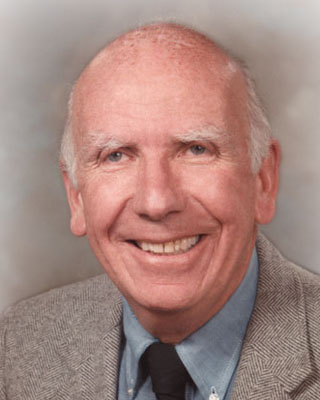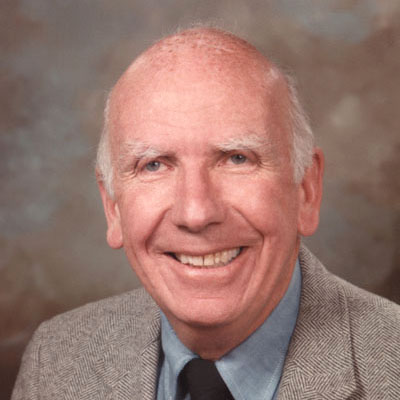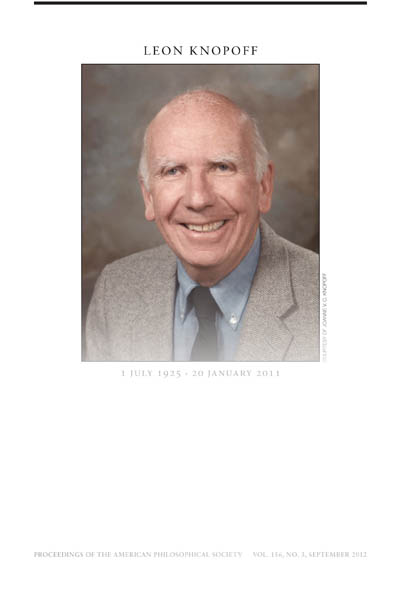By W. G. Ernst, Stanford,
Paul Davis and David Jackson, UCLA,
and Freeman Gilbert, UCSD
A man of unusually wide-ranging interests and talents, Leon Knopoff had the rare distinction of being simultaneously a professor of physics, a professor of geophysics, and a research musicologist at UCLA. The only child of Max and Ray Knopoff, Leon was born in Los Angeles on 1 July 1925, and was the first of his extended family to attend college. He died at his home on 20 January 2011.
As an undergraduate he studied electrical engineering (BS cum laude, 1944), and obtained his PhD in physics and mathematics (also cum laude) at the California Institute of Technology in 1949. In 1950 Louis Slichter recruited Knopoff to the Institute of Geophysics at UCLA, where he became professor of geophysics in 1957 and professor of both geophysics and physics in 1961. He was appointed research musicologist in the UCLA Institute of Ethnomusicology shortly after it was formed in 1960. Other appointments included faculty positions at Miami University of Ohio (1948–50) and Caltech (1962–63) as well as visiting academic appointments at Cambridge (three separate year-long visits), Karlsruhe, Harvard, Santiago, Trieste, and Venice. He was awarded an NSF Senior Postdoctoral Fellowship in 1960, and a Guggenheim Foundation Fellowship in 1976.
Knopoff was elected as a fellow of the American Geophysical Union (1962), a member of the National Academy of Sciences (1963), a fellow of the American Association for the Advancement of Science (1964), a fellow of the American Academy of Arts and Sciences (1965), and a member of the American Philosophical Society (1992). A true international scientist, he received the Emil Wiechert Medal of the Deutsche Geophysikalische Gesellschaft (1978), the gold medal of the Royal Astronomical Society (1979), the HF Reid Medal of the Seismological Society of America (1990)—thereby becoming an honorary member, the Golden Badge Award of the European Geophysical Society (2001), and a doctorate honoris causa from the Université Louis Pasteur, Strasbourg (2004). Leon was elected as a fellow of Selwyn College, Cambridge (1986). He first visited China in the 1970s, and returned often to collaborate with Chinese colleagues. He was named the first honorary professor of the Institute of Geophysics of the China Earthquake Administration (2004).
Leon served as the director of the Institute of Geophysics and Planetary Physics at UCLA for fourteen years, from 1972 to 1986. Among other professional responsibilities, he was founding member and secretary general of the International Upper Mantle Project; founder and chair of the International Union of Geodesy and Geophysics Committee on Mathematical Geophysics; chair of the US Upper Mantle Committee; chair of the US Committee for the International Association of Seismology and Physics of the Earth’s Interior; and chair of the Ad Hoc Committee on Seismology and Aftershocks, Atomic Energy Commission. Knopoff served as editor of
Non-Linear Processes in Geophysics and associate editor of
Reviews of Geophysics and Space Physics and Journal of Geophysical Research–Solid Earth.
His selfless cooperation was truly global, but nowhere was it more clearly demonstrated than at his own institution in his dedicated teaching of undergraduate and graduate students, his thirty-nine PhD students, forty postdoctoral fellows, and academic colleagues from more than seventeen countries. Knopoff was an inspiring teacher who excelled at simplifying complex topics and encouraging learning through his infectious animation and remarkable patience. It is not surprising that he won the "outstanding teacher award" in the UCLA physics department four times, which for him was a source of great pride. He was also honored as UCLA Faculty Research Lecturer in 1972.
Over the course of a long and extremely fruitful career, Leon authored or coauthored 232 scientific papers in refereed journals, as well as 134 other publications, including original research works in non-refereed journals, book chapters, and other reports and reviews. In addition, he edited or co-edited six books and research volumes.
Knopoff began his academic career with a series of laboratory experiments that compared seismic theory with observations. His laboratory skills led to collaboration with George Kennedy and the pioneering of the thermoluminescence dating of clay potshards and related materials an approach still utilized today in archaeology and art history. In 1956 his work took a theoretical turn, resulting in a famous paper that led to the representation theorem for calculating ground motions arising from body forces and motions on a surface such as an earthquake fault. In that paper, Knopoff extended to the elastodynamic problem Kirchhoff’s retarded potential solution to the wave equation, thereby providing the elastic analog to Green’s theorem. He often used his sense of humor to emphasize a point. He wrote a famous paper with the shortest title, "Q." This very complete work describes in detail the attenuation of elastic waves in the laboratory and in the Earth, and then follows with a thorough theoretical analysis of several mechanisms that might explain such attenuation. Published in 1964, "Q" continues to be widely quoted. In a refreshing contrast, he published with John Gardner a paper with the remarkably long title "Is the Sequence of Earthquakes in Southern California, with Aftershocks Removed, Poissonian?" followed by the shortest abstract, "Yes." Leon was an international leader in the theoretical and seismic exploration of planet Earth, ranging from California to the South Pole and the Alpine-Mediterranean realm—where he first recognized and described the low-velocity zone in the upper mantle – a lynchpin in the evolution of plate-tectonic theory. He accounted for the contrast in the slower spreading rates of continental versus oceanic plates as related to deep lithospheric keels beneath the continents, slowing their progress through the asthenosphere. He erected a theoretical framework explaining the double-couple model for earthquakes, elucidated the phenomena of self-organization and chaotic behavior in seismic systems, and pioneered pattern recognition in musicology as well as in earthquake frequencies. In avant-garde musical composition, during 1974 he copyrighted his own version of Mahler’s "Das Lied von der Erde" in two (Earth) movements, consisting of computer music. The first movement was based on seismicity from the Kern County earthquake, whereas the second was an accelerated digital recording of the normal modes of the Earth.
 L E O N K N O P O F F ____________________________________________________________________________________________________________
L E O N K N O P O F F ____________________________________________________________________________________________________________

